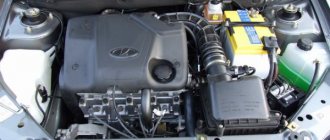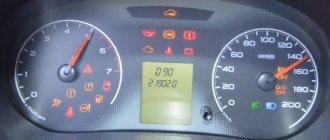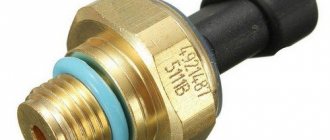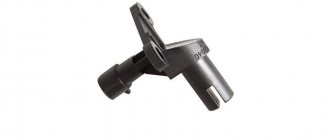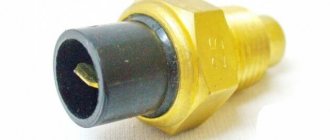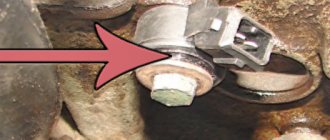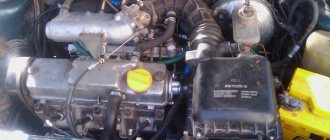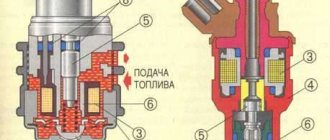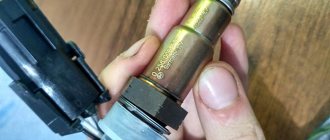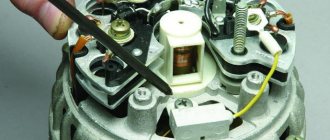This article describes all injector sensors on VAZ family cars. The article is generalized, since all sensors installed on cars of the Volzhsky Automobile Plant are identical to each other and even interchangeable.
After studying the article, you can easily determine the location of the sensor, understand its symptoms of malfunction, and also learn about its purpose. This material only talks about sensors on fuel-injected cars, since there are negligible numbers of engine control sensors in carburetor versions, and besides, there are fewer and fewer carburetor cars.
The engine control unit
All injection Ladas have a special unit that reads and processes readings from all sensors in the car system. This block is a small part made of plastic and metal, inside of which there is a microcircuit with many radio components. It is this block that sends signals to the fuel pump, injectors and ignition module, and also forms the ignition timing, controls the operation of fans, etc. This is a kind of car head unit.
Location
In all Lada models it is located in the cabin, in classic Lada models it is located under the glove box, in front-wheel drive Ladas the ECU is located under the center console. The location of the ECU can be called a problematic place in Lada Granta and Kalina cars, since the ECU is located under the heater radiator, which quite often exposes it to getting wet with antifreeze and disabling it. Many owners of these cars move the ECU under the glove box.
Symptoms of a problem
The unit does not have a malfunction as such; its failure may be associated with the failure of any of the sensors. For example, if one of the cylinders fails, the problem may lie not in the ignition module or coil, but in the key located in the ECU. Often a radio component that burns out inside the unit can affect the operation of any of the sensors.
Crankshaft position sensor
Installed on all Lada cars with an injection engine, it serves to determine the top dead center of the piston. Based on its readings, the engine control unit reads readings about the position of the pistons in the engine. After receiving the data, the ECU sends signals to the ignition module and injectors to supply a spark and fuel at the right time and into the right combustion chamber of a certain cylinder.
The sensor operates on the principle of electromagnetic induction. It itself is made of plastic, inside of which there is a magnet with a winding. A drive disk (crankshaft pulley) rotates next to the sensor, from which the sensor reads readings. There is a special slot on the pulley, the so-called “caries”, this slot makes it clear to the sensor what position the pistons and crankshaft are currently in.
Location
The sensor is located on all Frets in one place, near the generator drive pulley, this part is attached via a bolt. On the oil pump body there is a special cast bracket in the form of an ear; the sensor is inserted into it and secured with an M6 bolt.
Symptoms of a problem
If the crankshaft sensor fails, the car will not start due to a missing spark and injectors not working. Loss of communication with the sensor blocks the operation of the ignition module and injectors, causing fuel to enter the oil, etc. Also, if the sensor breaks down, the engine may start to stall, but this only happens when the sensor has not yet completely failed.
Knock sensor
With the advent of injection engines in Lada, regulation of the ignition timing angle (IAP) went into oblivion. This task began to be performed automatically, but as is known, the quality of the fuel also affects ignition, therefore, in order to avoid large detonations in the engine when using low-quality fuel, a knock sensor was used, which detects the slightest detonations in the engine and transmits the readings to the ECU, which in turn, changes the OZ to ensure normal engine operation.
The DD is a round part with a hole inside for attaching it to the engine body. It works similar to a piezoelectric element, that is, when struck, it produces a small electrical voltage. When detonations occur in the engine, the sensor detects them and transmits voltage pulses to the engine control unit to adjust the SOP.
Location
On all Lada models, regardless of the drive type, this part is located on the engine block and secured with a bolt. There are also sensors that themselves have a thread and are screwed into the body of the cylinder block. More precise location of the sensor in the center between cylinders 2 and 3.
Symptoms of a problem
If the sensor breaks down, the engine begins to operate in emergency mode, that is, the ECU can no longer adjust the OZ, and if you refuel with low-quality fuel, then an unpleasant knocking sound appears on the car, and its operation becomes uneven and rough, vibrations appear at idle and consumption increases fuel.
Pinout DS 2109, 2110, 2112, 2114, 2115
If you understand how to connect the speed sensor, then there is the following pinout that you should follow. At the same time, it is important to understand the essence of the operation of the DS to study the circuit diagram of the sensor, which is attached to this article.
The factory speed sensor of VAZ cars is manufactured with some differences in connections to the block connector. The square-shaped connector is used in Bosh electronics systems. The circle-shaped connector is used in electronic systems such as January 4 and GM.
When connecting a sensor, you should choose devices with contact group digitization such as “-”, “A”, “+” (internal designation on the block contacts) instead of digital designations such as “1”, “2”, “3”. In addition, preference should be given to devices with a metal-type rod, since plastic rods are very short-lived.
Coolant temperature sensor
In carburetor Lada models, the coolant temperature sensor was used to turn on the cooling fan, but in the injection version of cars, this DTOZ began to perform several functions. For example, the sensor in modern modes is involved in adjusting the fuel mixture, turning on the fan, and also displays information about the coolant temperature on the dashboard. The fuel mixture is adjusted based on temperature, that is, when the engine is cold, it needs a rich mixture, but when the engine is hot, the mixture needs to be leaner.
Location
The sensor can be found under the car air filter housing; it is located in the thermostat housing and is connected to a connector with two wires. The sensor is screwed in through a threaded connection, and a special O-ring is located between the DTOZH and the thermostat body.
Symptoms of a problem
When the sensor fails, the car experiences increased fuel consumption, as well as a lack of warm-up speed, the engine may begin to have trouble starting. All of these problems indicate a problem with the temperature sensor.
IMPORTANT NUANCES
There are several important points that cannot be left out. Here they are:
- The above sequence of replacing the sensor with completely draining the antifreeze is not always used. Experienced car enthusiasts do it simpler: they unscrew the faulty sensor, then clamp the drain hole with their finger. This action requires a fair amount of skill. But even if you do everything very quickly, some of the antifreeze will inevitably spill out and you will still have to top it up;
Sometimes car enthusiasts do not drain the antifreeze from the VAZ 2107 when replacing the sensor - When going to the store to buy a new temperature sensor, you should remember: you can now find both electromechanical and electronic temperature sensors on sale. It is better to choose electronic ones, despite the fact that they are more expensive than electromechanical ones (a good electronic sensor costs 500 rubles, and an electromechanical one - 300). The logic of choice is simple: the fewer moving parts there are in the sensor, the longer it will last.
So, replacing a temperature sensor is not a very difficult task. Even a novice car enthusiast can handle it if he has held a wrench in his hands at least once in his life. By precisely following the steps outlined in this instruction, the car owner can save about 700 rubles. This is how much it costs to replace a temperature sensor at a car service center.
Speed sensor
Older Lada models, such as the VAZ 2108 and Classic, used a mechanical speedometer drive, but with the advent of the injector, more electronics appeared in cars and the mechanical speedometer drive went into oblivion. Currently, an electronic speedometer is used in all Ladas; it is a part that works on the principle of electromagnetic induction, which reads readings from the crankshaft gear and transmits them to the engine control unit. The main task of the speed sensor is to calculate the speed, but in models with electric power steering, the speed sensor affects the operation of the power steering.
Location
The speed sensor is located predictably on the gearbox housing, near the gearbox oil level dipstick. The sensor is attached through a bolted connection, and the tightness is ensured by a special oil-resistant sealing ring.
Symptoms of a problem
If the sensor breaks down, the speedometer stops working or its readings become unreliable. In modifications of cars with electric power steering, if the sensor breaks down, the power steering may stop working.
Replacement
Before repairs, it is necessary to do preparatory work. Firstly, you will need a pit, overpass or lift. Secondly, you will need a tool: a powerful flat-head screwdriver and a 22mm open-end wrench. The sequence for removing the speed sensor on an injection VAZ 2107 is as follows:
- Unscrew the speedometer cable nut and remove it.
- Press the connector lock and disconnect the connection.
- Use a 22 mm wrench to unscrew the sensor itself.
Assembly of the unit is carried out in the reverse order. After replacement, most likely, a check light will light up on the instrument panel. This is a circuit fault. To fix the problem, you need to clear the error through the application.
Mass air flow sensor
All Lada models are equipped with a mass air flow sensor for injectors. It is used to count the air supplied to the car engine. For proper operation of an internal combustion engine, you need not only the presence of fuel, but also air. Fuel must be mixed with gasoline in the right proportions to prepare the correct fuel mixture, this is why a mass air flow sensor is needed, it calculates the amount of air entering the engine and transmits the readings to the ECU. The sensor is quite finicky and if the air filter is not changed in a timely manner, it can quickly fail, and its cost is high.
Location
The sensor can be found on the air filter housing; at the end, the sensor is attached via two bolts, and on the other side, a rubber corrugation is connected to it, which is secured with a large clamp. The MAF has a connector with several wires.
Symptoms of a problem
If the sensor breaks down, the engine starts to run unstably, starting is disrupted, and high fuel consumption occurs. If such malfunctions occur, the sensor can be checked.
Causes of clogging of the VAZ 2107 injector
Poor quality gasoline mainly causes problems with the injection system. This gasoline contains a high amount of heavy paraffins. They leave deposits on the walls of the fuel system, clogging it and making it difficult to supply fuel. When producing high-quality gasoline, special additives (detergents) are added that destroy such deposits. Low-quality gasoline contains a very high amount of paraffins that detergents do not have time to cope with their deposits.
- Such deposits accumulate not only in the nozzles. They can also settle on the throttle valve, which disrupts the proportionality of the fuel mixture that enters the cylinders.
- Layering may also appear on the exhaust valve plates, on their reverse side, for this reason the valve may burn out and detonation may occur when gasoline is burned.
- To clean the injection system from such deposits, it is necessary to use a special flushing fluid and some equipment. You can also clean the injector at home (in your garage). To do this you will need a washing liquid and a syringe.
Photo of flushing for the VAZ 2107 injector
Flushing fluid is added to gasoline and poured into the injection system through the brake hose. First, this procedure is done with the engine not running, then in its working condition. The mixture is fed into a running engine in small doses, slowly. This contributes to the destruction of the formed layers, which then, getting into the engine cylinders, burn out there. It should be borne in mind that during this procedure, black smoke may temporarily emit from the muffler.
Throttle position sensor
TPS is used to determine the opening angle of the valve inside the throttle. Such a sensor was installed only on mechanically driven throttle units; in mid-2012, almost all Lada cars began to be equipped with an electronic throttle, in which TPS was abandoned.
The sensor quite often failed due to its design, since there is a resistor inside it along which tracks run when the throttle is opened; very quickly these tracks became unusable due to rapid erasure and the sensor itself turned out to be inoperative.
Location
The TPS is located on the throttle assembly; it can be detected using a suitable wire. It is secured with two screws, and there is a foam sealing ring between the sensor and the remote control body.
Symptoms of a problem
When the TPS is broken, the speed spontaneously drops and rises in the region of 500-2500 rpm; this problem is quite difficult to confuse; it occurs quite often and this is the most important sign of a TPS malfunction. Also, if it breaks down, unstable operation of the internal combustion engine occurs, idle speed is lost and fuel consumption increases.
Checking for serviceability
Before checking the operating capabilities, it is worth paying attention to the fuses. Often their burnout causes sensor failure.
You can independently check the sensor for correct operation using certain tools: a household multimeter, a boiler, a thermometer. A container of water will also come in handy.
Instructions for checking:
- The entire threaded area of the sensor is placed in water.
- Together with the DTOZH, a thermometer is lowered into the container.
- The contacts of the multimeter and the sensor are connected, the resistance is measured.
- The boiler is immersed remotely from other devices and connected to the network, the liquid is heated.
- Indicative temperature is 95 °C. There should be no resistance with it. When the multimeter confirms this, it means that the spare part is functioning correctly. If resistance is observed, the device is broken.
Restoring the temperature sensor is not possible. There are no individual parts or materials available for sale that could be used to repair the device. The main reason is the cast housing design. The impossibility of disassembly does not provide access to the internals and, especially, to replace them.
Idle speed control
To regulate idle speed on Lada cars, an idle speed regulator (IAC) is used. It is an electric motor operating on direct current and a voltage of 12 V. The IAC has a worm gear, which is very unreliable and often fails. The role of the sensor is to open or close the idle speed channel. The IAC is only involved when the engine is idling and the throttle valve is closed. In modern Ladas, starting from 2012, the sensor was no longer used due to the transition to an electronic throttle unit.
Location
The idle speed control is located on the throttle body and is attached to the body with two screws. Between the regulator and the throttle body there is a rubber sealing ring, which very often wears out and begins to leak air.
Symptoms of a problem
If the sensor breaks down, the idle speed begins to drop to low values until the engine stops. Most often, the IAC becomes contaminated, after which it ceases to perform its functions.
Symptoms of a problem
In most cases, damage to the sensor on the injection VAZ-2107 is indicated by a yellow indicator on the instrument panel. In this case, you can notice that the car has become:
- Unstable operation at idle speed;
- show errors on the speedometer;
- consume more gasoline;
- bad pull.
It is recommended to carry out diagnostics, for example, through an application on a smartphone (ELM327 VAZ for Android), since the listed defects can be caused by problems with other elements of the system.
Oxygen sensor
With the advent of EURO standards, they began to care about emissions into the environment from cars. For this purpose, oxygen sensors (lambda probe) began to be used; it serves to determine the concentration of carbon dioxide in the exhaust gases of a car. If these parameters exceed the permissible values, the sensor sends a signal to the engine control unit to change the proportions of the fuel mixture and reduce harmful emissions into the environment.
Location
Depending on the vehicle configuration and year of manufacture, the number of oxygen sensors may change. Older models use a single oxygen sensor on the exhaust manifold. In cars with a catalyst, two oxygen sensors are used before and after the catalyst.
Symptoms of a problem
When the lambda probe fails, the car begins to consume more fuel, its power and previous dynamics are lost. Quite often, a breakdown in the DC can affect the operation of the entire engine; detonation and strong vibrations may occur at idle.
Camshaft sensor
The camshaft position sensor is installed on a car with a 16-valve engine. It is necessary for phased injection of fuel into the combustion chamber of the engine. This fuel injection allows you to achieve more power with less fuel consumption. If the sensor fails, the engine switches to parallel fuel injection mode.
Location
The camshaft sensor is located near the intake camshaft pulley. It reads readings from the rotation of the camshaft, namely from its pulley on which there is a special master disk.
Symptoms of a problem
As a rule, the breakdown of this sensor is quite difficult to notice, because this sensor does not perform any important functions, but only helps to save fuel. If the camshaft sensor fails, fuel consumption will increase
